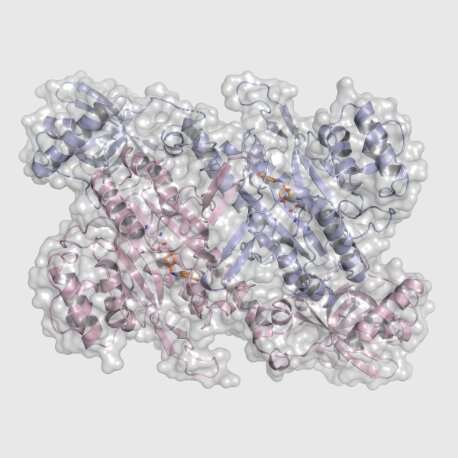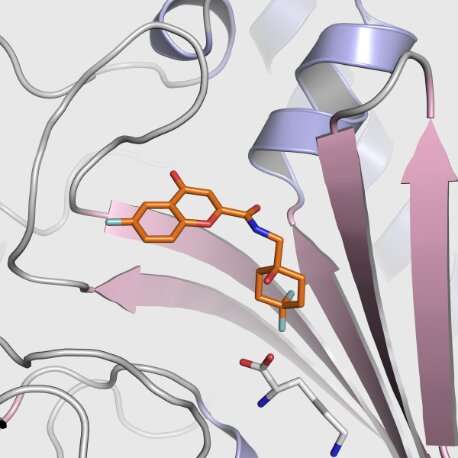Macromolecular crystallography shines a light on a new way to target the malaria parasite

The search for new treatments to combat malaria has been hampered by the lack of validated targets on the parasite that causes the disease. In work recently published in PNAS, a team from the Drug Discovery Unit at the University of Dundee present a new compound that is a selective inhibitor of the lysyl-tRNA synthetase enzyme in the parasites that cause malaria and cryptosporidiosis. Their work validates lysyl-tRNA synthetase as a drug target in these organisms and offers a strong lead for future drug discovery.
Controlling malaria and cryptosporidiosis
Malaria, caused by a parasite that is spread by mosquitos, caused more than 400,000 deaths worldwide in 2017. We need new drugs to tackle malaria, due both to a rise in resistance to existing treatments, and a need for simpler treatment regimens that are more easily completed. To progress towards the control and elimination of malaria, we will also need new medicines that can stop the transmission of the disease, and prevent patients from relapsing.
The gastrointestinal disease cryptosporidiosis is caused by a related parasite and spreads through contact with human or animal feces (often via contaminated water). In healthy individuals, symptoms generally subside in a couple of weeks. However, the disease can be fatal in patients with compromised immune systems, and malnourished children are particularly at risk. There is no effective treatment for infected children, and cryptosporidiosis is estimated to cause over 200,000 deaths each year.
Scientists are searching for new treatments, which work in novel ways, for both diseases. There are two approaches to the search for new malaria drugs. The first is phenotypic screening, which identifies compounds that kill the malaria parasite. For the last decade, the Medicines for Malaria Venture (MMV) has identified the majority of promising candidates in this way.
The second approach, target-based screening, looks for compounds that attack the parasite in specific ways. It is a more focused approach, using complementary methodologies to inform drug design. It has been a successful approach for many other diseases but has been hampered by a lack of validated targets for the malaria parasite.
MMV recently awarded their Project of the Year 2018 to a team of researchers led by Prof Ian Gilbert, Prof Kevin Read and Dr. Beatriz Baragaña at the Drug Discovery Unit (DDU) at the University of Dundee. Using Macromolecular Crystallography (MX), and complementary techniques, the team validated a novel biological target for both malaria and cryptosporidiosis and an exciting new compound series that shows activity against this target.

The power of a collaborative approach
The Dundee group were building on the work of a team led by microbiologist Prof Elizabeth Winzeler at the University of California San Diego. Prof Winzeler identified a natural fungal compound (cladosporin) that was active against malaria, and then identified its target.
Plasmodium falciparum is the parasite species responsible for the most dangerous form of malaria—falciparum malaria—and around 50% of all cases of malaria. The parasite has two different versions of lysyl-tRNA synthetase, an enzyme that is crucial to protein synthesis. Without this enzyme, the parasite cannot make proteins and hence survive. Cladosporin attacks one version of the enzyme, PfKRS1.
Cladosporin is not a suitable drug candidate in itself, but the DDU team were able to explore the potential of PfKRS1 as a novel therapeutic target, working through the Structure-guided Drug Discovery Coalition, funded by the Bill & Melinda Gates Foundation. Working in collaboration with Prof Wes van Voorhis at the University of Washington in Seattle, they screened libraries of compounds for potential PfKRS1 inhibitors.
From this screening, they found a chemical starting point. They have modified this to make a series of similar compounds, one of which proved to be effective against the parasites that cause malaria, metabolically stable, and suitable for further investigations. Macromolecular crystallography is crucial to this work, revealing the shape of molecules and insights into their function, and the crystallographers in the team worked at facilities in Seattle and New Delhi as well as at Diamond. The Dundee team have BAG (Block Allocation Group) access to Diamond, an access route specially designed for groups of users who require regular access, and who can coordinate different short experiments to fill a beamtime shift of 8 hours. For this particular work, they used Diamond's Microfocus MX beamline I24.
Their results offer a strong validation of lysyl-tRNA synthetase as a drug target for malaria and cryptosporidiosis. The team have identified a valuable tool compound, and their focus now is on improving the properties of the compound series. It's early days, but the goal would be to deliver a drug candidate that can pass all the safety milestones required to advance to clinical development.
According to Prof Gilbert, "This is a very exciting target, definitely worth exploring, but there's a lot of work still to do. It's important to be extremely rigorous in the early stages of drug development. It will be some time before we know whether this work will lead to a new drug treatment."
For Dr. Timothy Wells, MMV's Chief Scientific Officer, "This work represents a step forward from business-as-usual drug discovery. Having a greater understanding of the structure of the drug target has been like shining a bright light on the work to optimize the drug series—it means we can be really precise as we improve the selectivity and potency of the compounds."
More information: Beatriz Baragaña et al. Lysyl-tRNA synthetase as a drug target in malaria and cryptosporidiosis, Proceedings of the National Academy of Sciences (2019). DOI: 10.1073/pnas.1814685116
Journal information: Proceedings of the National Academy of Sciences
Provided by Diamond Light Source



















